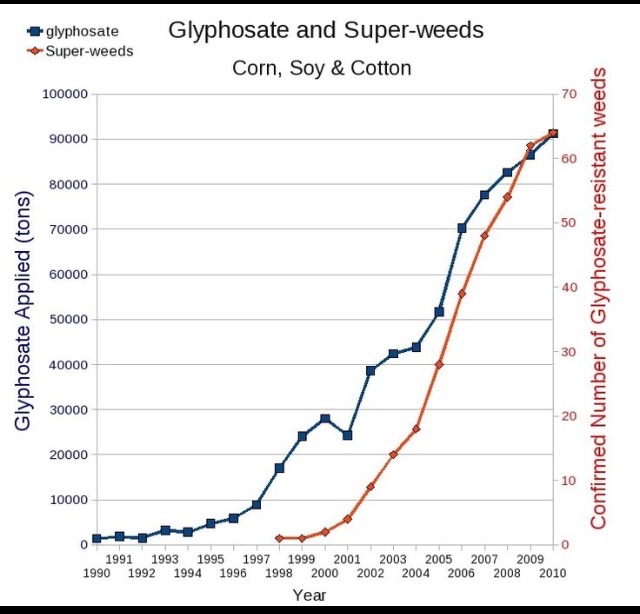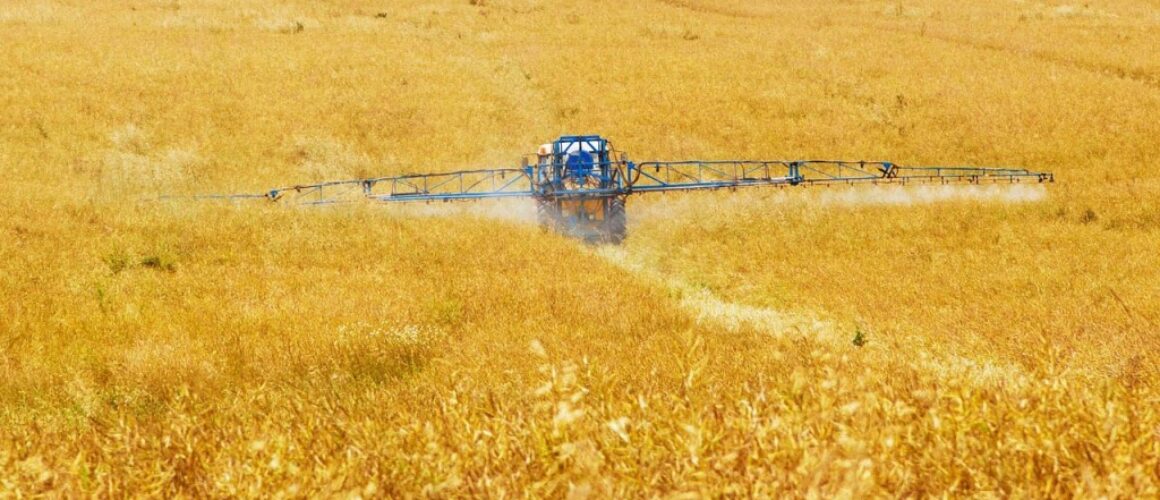Study: Monsanto’s Glyphosate Now Most Heavily Used Weed-Killer in History
Washington, D.C. – Monsanto’s signature herbicide glyphosate, first marketed as “Roundup,” is now the most widely and heavily applied weed-killer in the history of chemical agriculture in both the U.S. and globally, according to a landmark report published today in the journal, Environmental Sciences Europe.
Since 1974 in the U.S., over three billion, five hundred twenty million pounds of glyphosate active ingredient have been applied. Globally, glyphosate use has risen almost 15-fold since so-called “Roundup Ready,” genetically engineered crops were introduced in 1996
It’s a brilliant earnings model for a chemical company that is selling it. Genetically engineer seeds to withstand increasing applications of glyphosate, and you can sell more of your signature product. A look to Monsanto’s earnings reports from the last ten years tell us exactly that: the sales in their agrochemical division of their signature product, Roundup, took off.
A paper published this week in the peer-reviewed journal Environmental Sciences Europe reports that 18.9 billion poundsof glyphosate have been used globally. Glyphosate use has risen almost 15-fold since so-called “Roundup Ready” genetically engineered crops were introduced in 1996.
Genetically engineered herbicide-tolerant crops now account for about 56 % of global glyphosate use.
The paper by Charles Benbrook, PhD, titled “Trends in glyphosate herbicide use in the United States and globally,” and is available free, online at [Environmental Sciences Europe].
“The dramatic and rapid growth in overall use of glyphosate will likely contribute to a host of adverse environmental and public health consequences,” noted Dr. Benbrook in his paper.
In the spring of 2015, the World Health Organization declared glyphosate a “probable carcinogen.”
Record amounts are going onto food crops around the world, and because these genetically engineered foods are not labeled in the United States, many Americans still have no idea.
The President’s Cancer Panel reported that 1 in 2 men and 1 in 3 women are expected to get cancer in their lifetimes. Cancer is now the leading cause of death by disease in American children under the age of 15, according to the Centers for Disease Control.
Correlation is not causation, but a correlation of this magnitude merits investigation and precaution. Precaution begins with labeling these genetically engineered ingredients (GMOs).
Last year, 17 of the world’s top cancer researchers unanimously voted to elevate the cancer profile of glyphosate on behalf of the World Health Organization. The WHO’s International Agency for Research on Cancer (IARC) now classifies the weed-killer as “probably carcinogenic to humans” after the panel of experts reviewed all of the publicly available research. Following up on the action by the WHO, the state of California is currently in the process of listing glyphosate as a known human carcinogen under its Prop 65 law.
As the paper notes, recent studies have made the connection between glyphosate exposure and a number of serious health effects beyond cancer, including the degeneration of the liver and kidney, as well as non-Hodgkin lymphoma, among others.
Benbrook’s paper isn’t the first to call attention to this. According to National Geographic, “introduced commercially by Monsanto in 1974, glyphosate kills weeds by blocking proteins essential to plant growth…more than 1.4 billion pounds (are) applied per year. Its use skyrocketed after seeds were genetically engineered to tolerate the chemical…. Between 1987 and 2012, annual U.S. farm use grew from less than 11 million pounds to nearly 300 million pounds.
Glyphosate, the key ingredient in Monsanto’s signature product Roundup, was initially used as a descaling agent to clean out calcium and other mineral deposits in pipes and boilers of residential and commercial hot water systems by the Stauffer Chemical Company. It has been banned in the Netherlands.
Remarkably, 74 percent of all the glyphosate sprayed on crops since the mid-1970s has been applied in just the last 10 years as the amount of genetically engineered corn and soybean crops have exploded on both U.S. and global croplands.
First sold commercially in 1974, the use of glyphosate by farmers was limited since this active ingredient kills both weeds and agronomic crops. The development and approval of genetically engineered (GE), herbicide-tolerant (HT) crops dramatically changed how farmers could apply glyphosate. Starting in 1996, GE-HT versions of three major crops – cotton, corn, and soybeans – were marketed by Monsanto and other seed companies, making it possible for farmers to apply glyphosate for months after crops had started growing.
 The use and efficacy of HT technology, particularly in its first decade, led to rapid and near-universal adoption in the U.S., Canada, Argentina, Brazil, and a half-dozen other countries. As a result, glyphosate use by farmers in the U.S. rose from 12.5 million pounds in 1995 to 250 million pounds in 2014, a 20-fold increase. Globally, total use rose from 112.6 million pounds in 1995 to 1.65 billion in 2014, a 14.6-fold jump. Not surprisingly, farms reacted to this sudden and increased use: super weeds, weeds that no longer respond to the application of Roundup and glyphosate, are now found across over half of the states in the U.S.
The use and efficacy of HT technology, particularly in its first decade, led to rapid and near-universal adoption in the U.S., Canada, Argentina, Brazil, and a half-dozen other countries. As a result, glyphosate use by farmers in the U.S. rose from 12.5 million pounds in 1995 to 250 million pounds in 2014, a 20-fold increase. Globally, total use rose from 112.6 million pounds in 1995 to 1.65 billion in 2014, a 14.6-fold jump. Not surprisingly, farms reacted to this sudden and increased use: super weeds, weeds that no longer respond to the application of Roundup and glyphosate, are now found across over half of the states in the U.S.
“My hope is that this paper will stimulate more research on glyphosate use, and human and environmental exposure patterns, to increase the chance that scientists will quickly detect any problems that might be triggered, or made worse by glyphosate exposure,” Benbrook added.
“This report makes it clear that the use of glyphosate combined with the dominance of genetically engineered crops has produced an looming public health threat.
U.S. and around the world,” said Mary Ellen Kustin, a senior policy analyst at EWG. “Farmers have sprayed billions of pounds of a chemical now considered a probable human carcinogen over the past decade. Spraying has increased to multiple times a year recently on the majority of U.S. cropland. The sheer volume of use of this toxic weed- killer is a clear indication that this chemical dependency is a case of farming gone wrong.”
This is Benbrook’s second paper published in Environmental Sciences Europe. The first, “Impacts of genetically engineered crops on pesticide use in the U.S. – the first sixteen years,” was published in September 2012 and remains the most heavily accessed paper in the 25-year history of Environmental Sciences Europe, with over 230,000 reviews.
###
References: Benbrook, C. Trends in glyphosate herbicide use in the United States and globally. Environmental Sciences Europe (2016, 28:28) DOI ???
Benbrook, C. “Impacts of genetically engineered crops on pesticide use in the U.S. – the first sixteen years.” Environmental Sciences Europe (2012, Vol. 24:24. doi:10.1186/2190-4715-24-24. Access full text at: http://www.enveurope.com/content/24/1/24
Both reports are part of Springer’s open access publishing portfolio. SpringerOpen and is freely available online.
